Abstract
The hematopoietic growth factor GM-CSF (granulocyte-macrophage colony-stimulating factor) is expressed by activated but not resting T lymphocytes. Previously, we localized GM-CSF-inducible promoter activity to a 90-bp region of GM-CSF 5'-flanking sequences extending from bp -53 to +37. To more precisely identify the GM-CSF DNA sequences required for inducible promoter activity in T lymphocytes, we have performed mutagenesis within a region of GM-CSF 5'-flanking sequences (bp -57 to -24) that contains the repeated sequence CATT(A/T). Mutations that do not alter the repeated CATT(A/T) sequence do not eliminate inducible promoter activity, whereas mutation or deletion of either of the CATT(A/T) repeats eliminates all inducible promoter activity in T-cell lines and in primary human T lymphocytes. Thus, both copies of the direct repeat CATT(A/T) are required for mitogen-inducible expression of GM-CSF in T cells.
Full text
PDF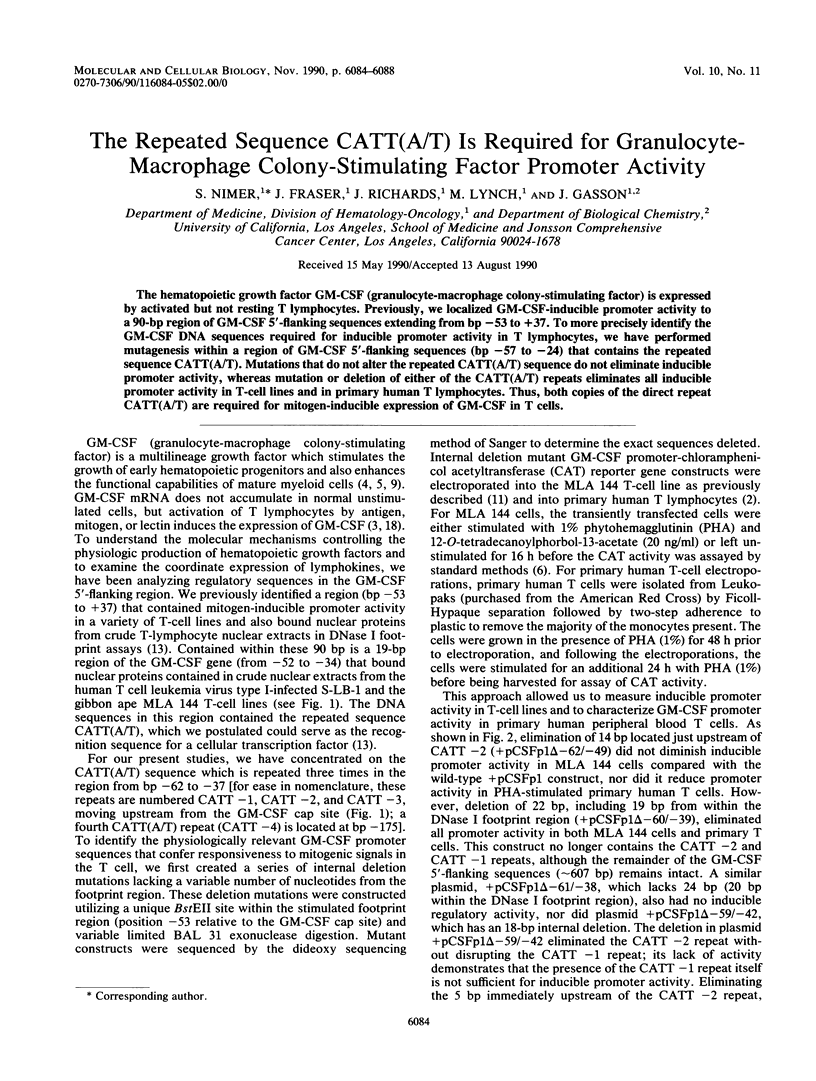
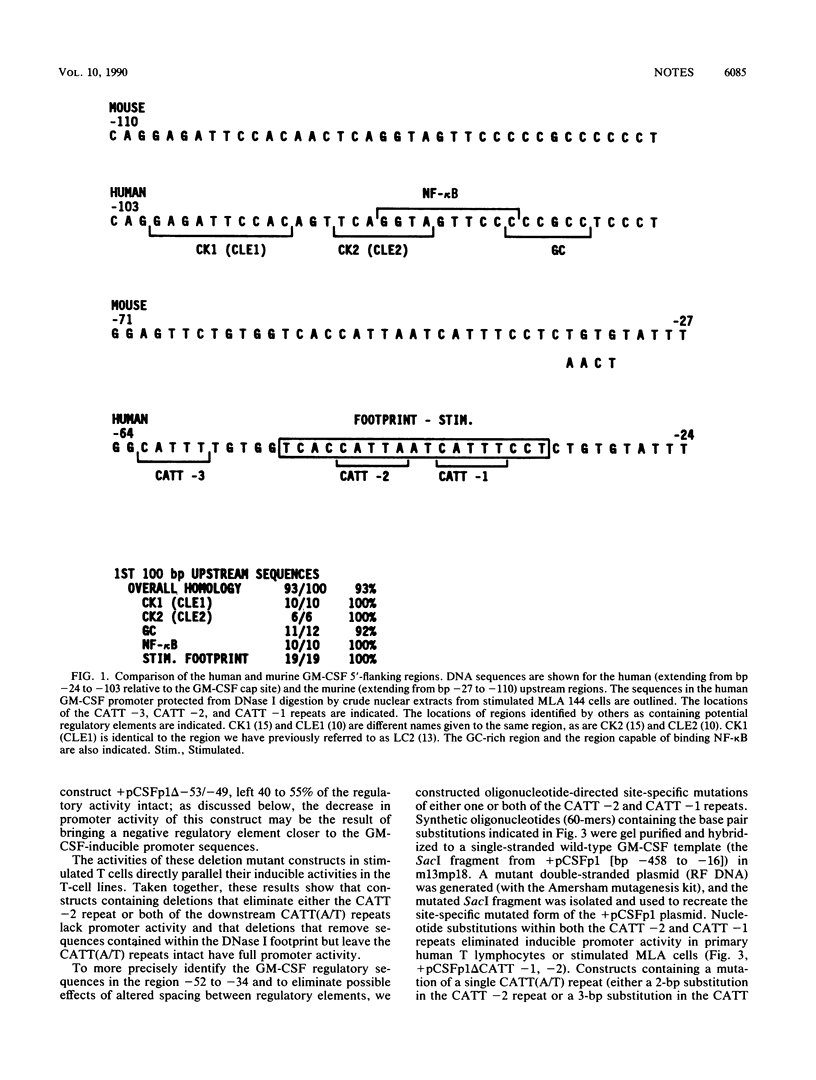
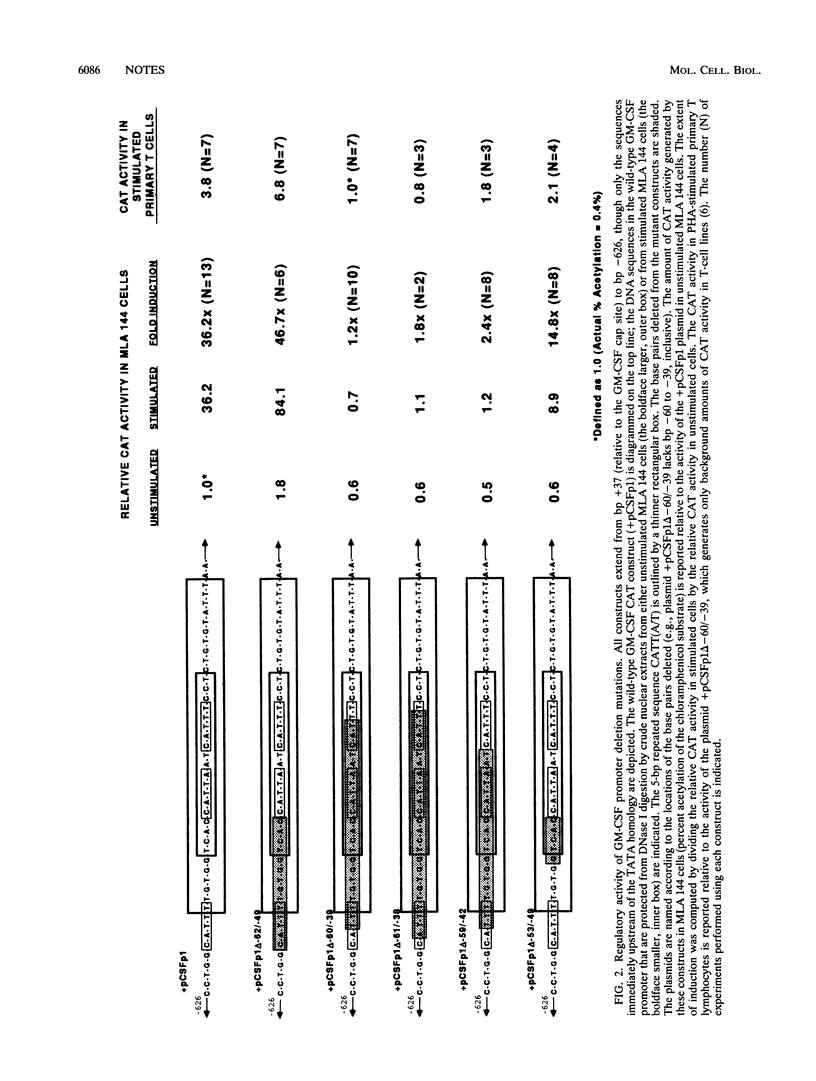
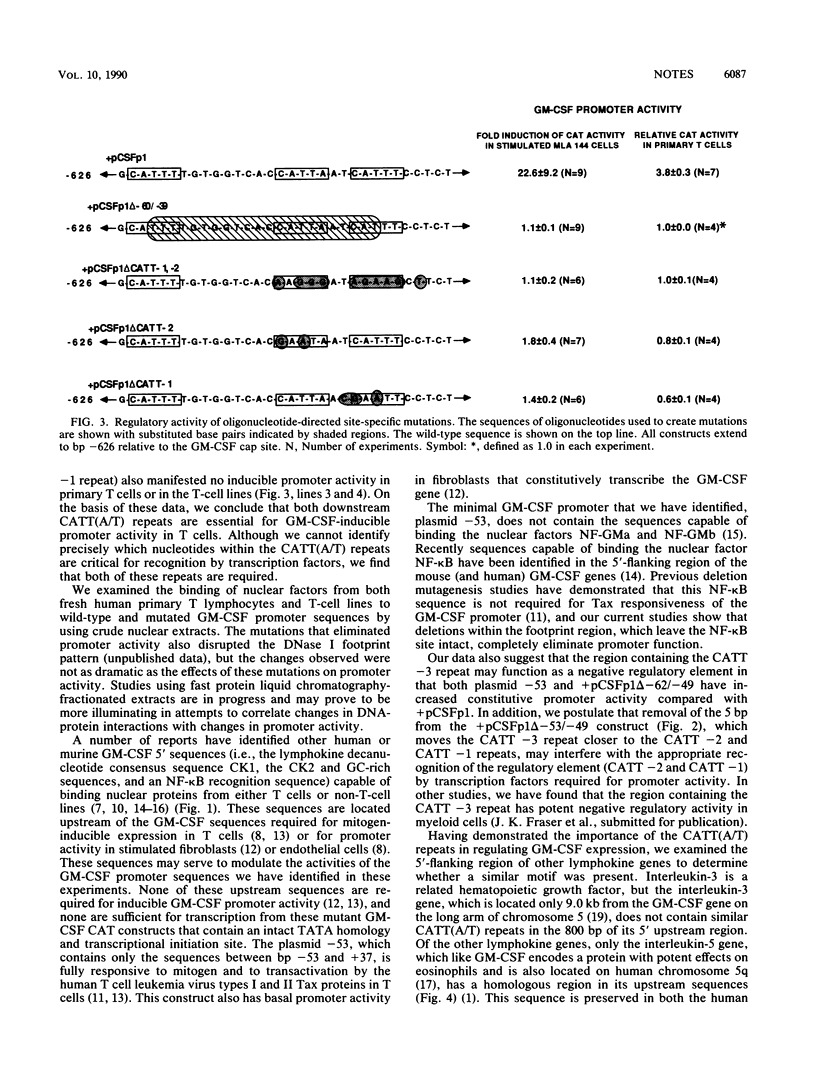
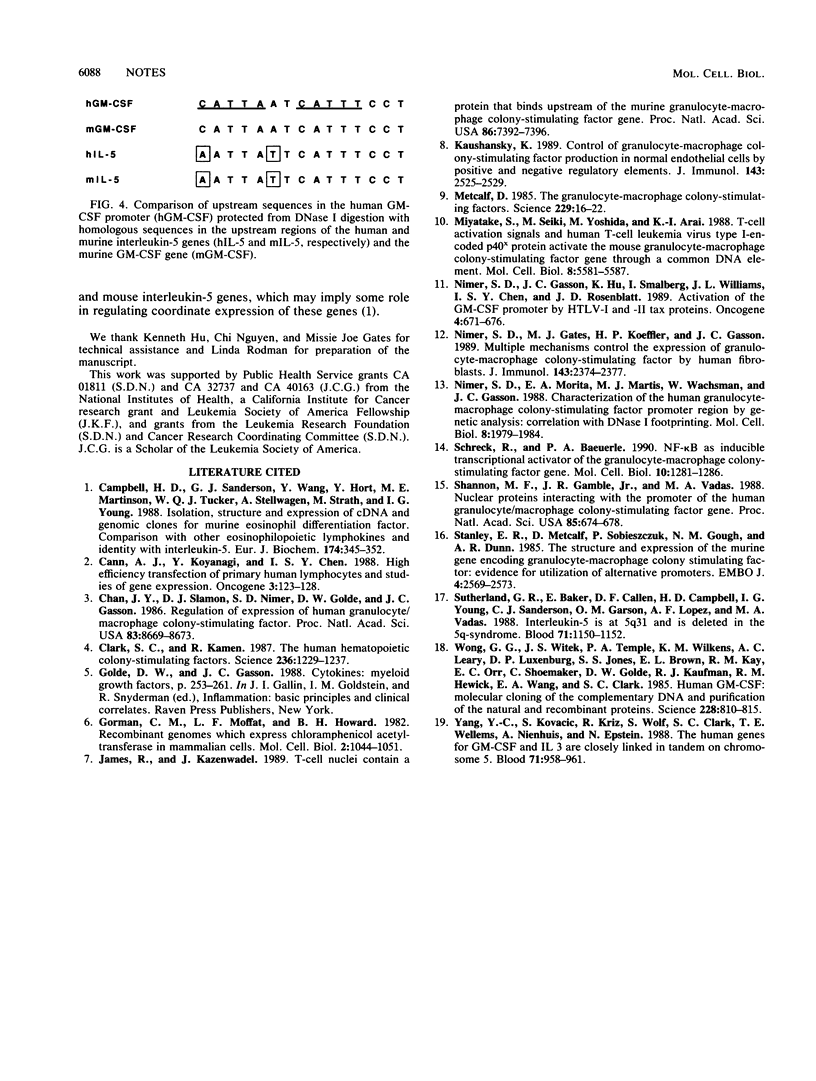
Selected References
These references are in PubMed. This may not be the complete list of references from this article.
- Campbell H. D., Sanderson C. J., Wang Y., Hort Y., Martinson M. E., Tucker W. Q., Stellwagen A., Strath M., Young I. G. Isolation, structure and expression of cDNA and genomic clones for murine eosinophil differentiation factor. Comparison with other eosinophilopoietic lymphokines and identity with interleukin-5. Eur J Biochem. 1988 Jun 1;174(2):345–352. doi: 10.1111/j.1432-1033.1988.tb14104.x. [DOI] [PubMed] [Google Scholar]
- Chan J. Y., Slamon D. J., Nimer S. D., Golde D. W., Gasson J. C. Regulation of expression of human granulocyte/macrophage colony-stimulating factor. Proc Natl Acad Sci U S A. 1986 Nov;83(22):8669–8673. doi: 10.1073/pnas.83.22.8669. [DOI] [PMC free article] [PubMed] [Google Scholar]
- Clark S. C., Kamen R. The human hematopoietic colony-stimulating factors. Science. 1987 Jun 5;236(4806):1229–1237. doi: 10.1126/science.3296190. [DOI] [PubMed] [Google Scholar]
- Gorman C. M., Moffat L. F., Howard B. H. Recombinant genomes which express chloramphenicol acetyltransferase in mammalian cells. Mol Cell Biol. 1982 Sep;2(9):1044–1051. doi: 10.1128/mcb.2.9.1044. [DOI] [PMC free article] [PubMed] [Google Scholar]
- James R., Kazenwadel J. T-cell nuclei contain a protein that binds upstream of the murine granulocyte-macrophage colony-stimulating factor gene. Proc Natl Acad Sci U S A. 1989 Oct;86(19):7392–7396. doi: 10.1073/pnas.86.19.7392. [DOI] [PMC free article] [PubMed] [Google Scholar]
- Kaushansky K. Control of granulocyte-macrophage colony-stimulating factor production in normal endothelial cells by positive and negative regulatory elements. J Immunol. 1989 Oct 15;143(8):2525–2529. [PubMed] [Google Scholar]
- Metcalf D. The granulocyte-macrophage colony-stimulating factors. Science. 1985 Jul 5;229(4708):16–22. doi: 10.1126/science.2990035. [DOI] [PubMed] [Google Scholar]
- Miyatake S., Seiki M., Yoshida M., Arai K. T-cell activation signals and human T-cell leukemia virus type I-encoded p40x protein activate the mouse granulocyte-macrophage colony-stimulating factor gene through a common DNA element. Mol Cell Biol. 1988 Dec;8(12):5581–5587. doi: 10.1128/mcb.8.12.5581. [DOI] [PMC free article] [PubMed] [Google Scholar]
- Nimer S. D., Gasson J. C., Hu K., Smalberg I., Williams J. L., Chen I. S., Rosenblatt J. D. Activation of the GM-CSF promoter by HTLV-I and -II tax proteins. Oncogene. 1989 Jun;4(6):671–676. [PubMed] [Google Scholar]
- Nimer S. D., Gates M. J., Koeffler H. P., Gasson J. C. Multiple mechanisms control the expression of granulocyte-macrophage colony-stimulating factor by human fibroblasts. J Immunol. 1989 Oct 1;143(7):2374–2377. [PubMed] [Google Scholar]
- Nimer S. D., Morita E. A., Martis M. J., Wachsman W., Gasson J. C. Characterization of the human granulocyte-macrophage colony-stimulating factor promoter region by genetic analysis: correlation with DNase I footprinting. Mol Cell Biol. 1988 May;8(5):1979–1984. doi: 10.1128/mcb.8.5.1979. [DOI] [PMC free article] [PubMed] [Google Scholar]
- Schreck R., Baeuerle P. A. NF-kappa B as inducible transcriptional activator of the granulocyte-macrophage colony-stimulating factor gene. Mol Cell Biol. 1990 Mar;10(3):1281–1286. doi: 10.1128/mcb.10.3.1281. [DOI] [PMC free article] [PubMed] [Google Scholar]
- Shannon M. F., Gamble J. R., Vadas M. A. Nuclear proteins interacting with the promoter region of the human granulocyte/macrophage colony-stimulating factor gene. Proc Natl Acad Sci U S A. 1988 Feb;85(3):674–678. doi: 10.1073/pnas.85.3.674. [DOI] [PMC free article] [PubMed] [Google Scholar]
- Stanley E., Metcalf D., Sobieszczuk P., Gough N. M., Dunn A. R. The structure and expression of the murine gene encoding granulocyte-macrophage colony stimulating factor: evidence for utilisation of alternative promoters. EMBO J. 1985 Oct;4(10):2569–2573. doi: 10.1002/j.1460-2075.1985.tb03972.x. [DOI] [PMC free article] [PubMed] [Google Scholar]
- Sutherland G. R., Baker E., Callen D. F., Campbell H. D., Young I. G., Sanderson C. J., Garson O. M., Lopez A. F., Vadas M. A. Interleukin-5 is at 5q31 and is deleted in the 5q- syndrome. Blood. 1988 Apr;71(4):1150–1152. [PubMed] [Google Scholar]
- Wong G. G., Witek J. S., Temple P. A., Wilkens K. M., Leary A. C., Luxenberg D. P., Jones S. S., Brown E. L., Kay R. M., Orr E. C. Human GM-CSF: molecular cloning of the complementary DNA and purification of the natural and recombinant proteins. Science. 1985 May 17;228(4701):810–815. doi: 10.1126/science.3923623. [DOI] [PubMed] [Google Scholar]
- Yang Y. C., Kovacic S., Kriz R., Wolf S., Clark S. C., Wellems T. E., Nienhuis A., Epstein N. The human genes for GM-CSF and IL 3 are closely linked in tandem on chromosome 5. Blood. 1988 Apr;71(4):958–961. [PubMed] [Google Scholar]


